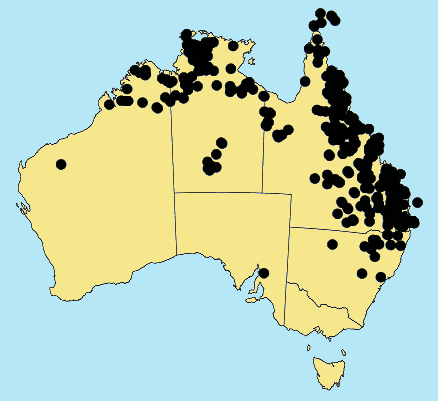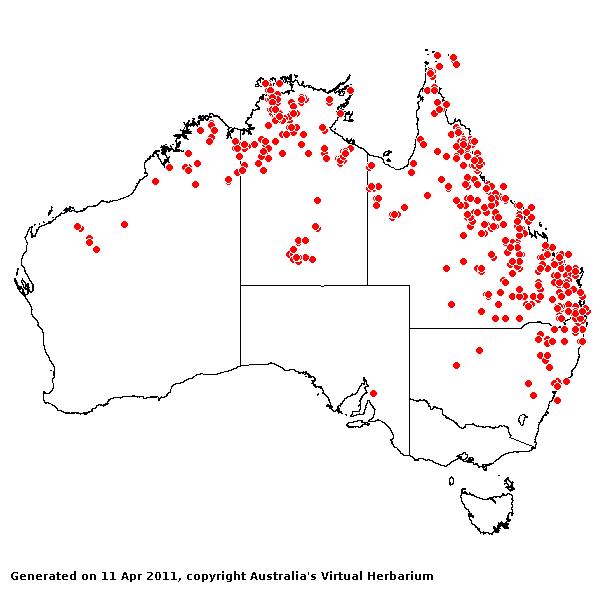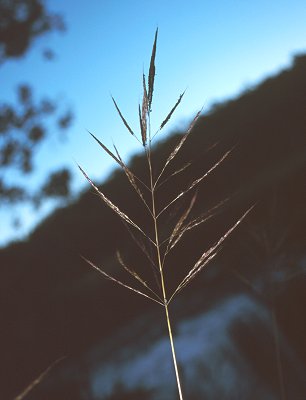Bothriochloa bladhii (Retz.) S. T. Blake. Proc.
Roy. Soc. Queensland 80: 62 (1969).
Classification. (GPWG 2001) : Subfamily Panicoideae. Micraireae.
Basionym and/or
Replacement Name: Andropogon
bladhii Retz., Observ. Bot. 2: 27 (1781).
Type of Basionym or
Protologue Information: China: ?:, Bladh s.n. (HT: LD; IT: SI
(photo)).
Recent synonyms:
B. intermedia.
Key references
(books and floras): [1810]. R.Brown, Prodromus (202 as Andropogon
intermedius), [1878] G.Bentham, Flora Australiensis 7 (531 as Andropogon
intermedius), [1969] E.E.Henty, Manual Grasses New Guinea (36
as B. intermedia), [1980] M.Lazarides, Tropical Grasses S.E.Asia
(24), [1981] M.Lazarides in J.Jessop (ed)., Flora of Central Australia
(487), [2002] D.Sharp & B.K.Simon, AusGrass, Grasses of Australia,
[2008] S.W.L.Jacobs, R.D.B.Walley & D.J.B.Wheeler, Grasses of New South
Wales (168).
Illustrations:
[1983] J.C.Tothill & J.B.Hacker, Grasses of Southern Queensland (126
& 128(4)).
Habit.
Perennial. Rhizomes present, short. Culms erect or geniculately ascending,
50–150 cm tall. Lateral branches simple or sparsely branched. Ligule an
eciliate membrane. Leaf-blades 10–55 cm long, 2–12 mm wide.
Inflorescence.
Inflorescence compound, a panicle of racemes, with ramose branches. Panicle
3–14 cm long. Racemes numerous, 1.8–5 cm long. Central inflorescence axis 4-14
cm long. Rhachis fragile at the nodes.
Spikelets.
Spikelets sessile, 1 in the cluster. Companion spikelets pedicelled, 1 in the
cluster. Companion spikelets developed, comprising 2 subequal glumes without
lemmas or containing empty lemmas or male, 2.5–4 mm long. Fertile spikelets
2-flowered, the lower floret barren (rarely male), the upper fertile,
comprising 1 basal sterile florets, comprising 1 fertile floret(s), without
rachilla extension, elliptic or oblong, dorsally compressed, 3–4 mm long.
Glumes. Glumes
dissimilar, firmer than fertile lemma. Lower glume elliptic, chartaceous,
without keels, 5–7 -nerved. Lower glume surface indumented. Upper glume
lanceolate or oblong, keeled, 1-keeled, 3–4 -nerved. Florets. Basal
sterile florets 1, barren, without significant palea. Lemma of lower sterile
floret hyaline, 0 -nerved.
Fertile lemma without
keel, 1 -nerved. Lemma apex entire, awned, 1 -awned. Median (principal) awn
10–25 mm long overall, with a twisted column. Palea absent. Grain 2 mm long.
Continental
Distribution: Africa, Temperate Asia, Tropical Asia, Australasia, Pacific,
and South America.
Australian
Distribution: Western Australia, Northern Territory, South Australia,
Queensland, New South Wales, Christmas Is.
Western Australia:
Gardner, Fitzgerald, Hall, Dampier. Canning, Fortescue. Northern Territory:
Darwin & Gulf, Victoria River, Barkly Tableland, Central Australia North,
Central Australia South. South Australia: Gairdner-Torrens Basin,
Flinders Ranges. Queensland: Burke, Burnett, Cook, Darling Downs,
Leichhardt, Maranoa, Mitchell, Moreton, North Kennedy, Port Curtis, South
Kennedy, Warrego, Wide Bay. New South Wales: North Coast, Northern
Tablelands, North-Western Slopes, Central-Western Slopes, North-Western Plains.
There are two subspecies.
Sessile spikelets not or very rarely pitted,
3.5–4 mm long subsp. bladhii
Sessile spikelets always pitted, 3–3.5 mm long
subsp. glabra






